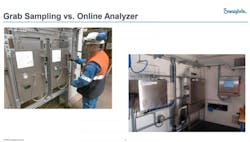Understanding the benefits of a high-performing grab sampling system
Matt Dixon began his career with Swagelok in 1998 as an engineering co-op student. Dixon has extensive experience in sampling systems, including developing the grab sample module (GSM) and grab sample liquid (GSL) product lines and developing Swagelok’s ammonia sampling system. During the Q&A portion of the webinar, “How to Develop the Right Grab Sampling System for Your Plant” Dixon examined the basic system design principles of a grab sampling system and how customization can be the key to success.
PS: Can you use one grab sampling panel to sample from multiple or different locations?
MD: You can. This is more common in online analyzer applications where you have an expensive analyzer that you don't want to use for just one sample point. And so you have multiple streams coming in from different locations, and you use the stream selection to select which stream is going onto the analyzer.
You can do something similar with grab sample panels where you have a single panel that serves multiple streams, but to be honest, in most cases, it's just not worth it. The economics don't work out. Just the cost of the stream selection and piping the samples in from different places in the facility doesn't make a whole lot of sense, because the cost of the grab sample panel is typically low enough to where you can just install a single grab panel at each sampling location.
PS: Is there any type of remote control system that Swagelok offers to avoid things like time delays?
MD: We can do lots of different automation options for grab sampling systems. We can initiate the grab sampling cycle remotely, either through discrete controls or through the plant DCS system, and have all sorts of sensors remotely at the grab sample panel to make sure that the sample container is in place and that the valves are actuating, etc.
All of that is possible, and that way you don't have to send the operator out and worry about them collecting the sample correctly. You have that automation taking care of it, and then when the operator does show up to collect the sample, it's there waiting for them.
PS: What options do you have for sour gas applications, especially for sample cylinders?
MD: I think a lot of people are aware of sour gas applications. Typically, you have to worry about the materials of the construction, and specifically, you need to make sure that the materials meet the requirements of NACE. The NACE requirements are laid out in terms of what materials are acceptable, and among those materials, what sort of hardness is acceptable.
One of the things that you can't have, for example, is strain-hardened stainless-steel components that aren't tube fittings. Those strain-hardened stainless-steel valves or strain-hardened stainless steel pipe fittings have to be annealed. So, we can absolutely provide those in the annealed condition in order to make sure that they are meeting the NACE requirements for those sour gas applications; or, if the situations dictate, we can move to an alloy 400 or a Monel system for the ones that have a higher concentration of sour gas.
PS: Does Swagelok offer systems with alternative materials such as Monel or Hastelloy to suit critical or aggressive fluids?
MD: Monel and Hastelloy are definitely two pretty common requests for us, Monel more so just because of the application, but Hastelloy on occasions. Obviously, you don't want to go to those exotic alloys if you don't have to because they do have a cost associated with them relative to stainless steel. But we've definitely provided these systems in both Monel and Hastelloy and other alloys well. It really comes down to the availability of components.


